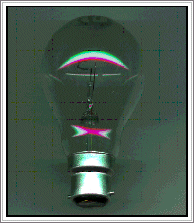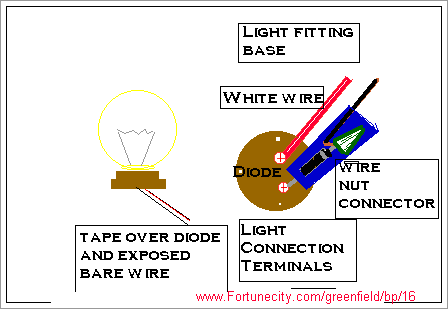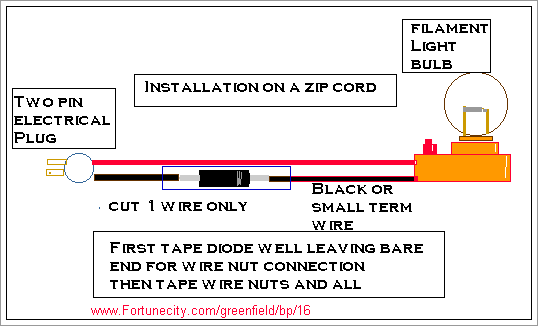

Saving a Light Bulb Idea
For your Light Bulbs to extend their life up to 27 times longer. If you have a hard to change or bulb that just burns out too often and you do not demand bright light but constant light, this is for you. There is a trick that when you put a diode, a electrical rectifier in line with a light bulb you feed it DC current.
This is only half wave of the AC voltage available so the bulb is not as bright but will seem that it probable never burn out I have heard of bulbs 8 years continuous use. They will burn out eventually but the diode will last many years and bulbs lives. Diodes are $ 1-3.00 and wire nuts cheap.
To compensate for the light loss you can just put a 100 watt in place of a 60 watt or if you wanted a 40 watt put in a 60 watt or a 150 where you wanted a 100 watt it will still be a little less brightness so may not be recommended for reading lights.
This is only for filament light bulbs only not fluorescent fixtures or any other neon or halogen or any lights with starters and capacitor or transformers
To change a regular electrical socket just follow these directions. With the power switched on, find the fuse circuit and remove the fuse or shut off the breaker if the light goes out you know you have the right one.
Then simply disassemble the socket and connect a diode rectifier in line with the bulb circuit. To do this disconnect one wire from the socket, bend the one diode wire to shape around the screw and tighten.
Then twist the other wire of the diode to the wire and use a wire connector or wire nut. Then . use electrician's tape, layer it over pretty good on all the wires as well as the centre of the diode itself
Carefully push the diode and wire up so where they will not touch the electrical box or fixture and replace screws, bulb and Fuse or turn on circuit breaker
For a table lamp, depending on the base or in the head, where ever you can find room to fit the diode and tape, wherever the wire is running, then just cut the black or line wire, strip each end of the wire twisting the strands together first, then connect the diode wires in twisting it together securely in the right direction before screwing on the wire nut.
Wire nuts are made to thread on .the same direction as reg nuts twist the wire the same direction. Try not to disturb the wire of the diode and not have direct pull or push at the diode. The diode, if installed correctly will last many years as long as the voltage does no go above the peak inverted volts and the amperage is less than half of rated. A 100 watt bulb 120 volts normally draws just under 1 amp.
You want to over rate pretty good, so a diode rated 2 amperes and 200 volts diode will do, as the amps and voltage rating goes up so do cost and life expectancy. If you have a many fixture with a few bulbs you can use a 8 amp diode for say 5 bulbs and the VOLTAGE rating could stay at 200 Volts One thing to remember is that if you are changing many lights, then be sure to alternate the diodes direction on installations.
This will balance the electricity use and keep things even on your meter readings. If you are doing an old style lamp that does not have the one wide tab then direction does not matter. If it does have this or the three prong outlet just put one in one direction and the next one the opposite.
You can get 400 volt diodes not much more cost then the better, sometimes they may have 12 amps on sale less than 5 amps it matters not the Physical size as long as you can make them fit The amp size must be over and the voltage also. If you got a 30 amp diode but only rated 100 volts it would blow with one bulb the voltage should be at least 200
Because even though it is only supplied 120 volts it may spike up to 180 at times or where you are on the grid even higher. The farthest people from the generating stations get more varied voltage.
On thing you should do is label any lamp or fixture converted so if in a few years when the bulb does not work but is because the diode does fail, you will know to change the diode.
You can write on medical adhesive tape or just mark the socket with a marker pen and the word Diode or DC power.
It may not be good for your reading lights and some diodes will go bad but the money saved in light bulbs and aggravation of changing them will certainly help you .
HERE ARE SOME SIMPLE DRAWINGS TO HELP.



email supplier of this article for any additional information

